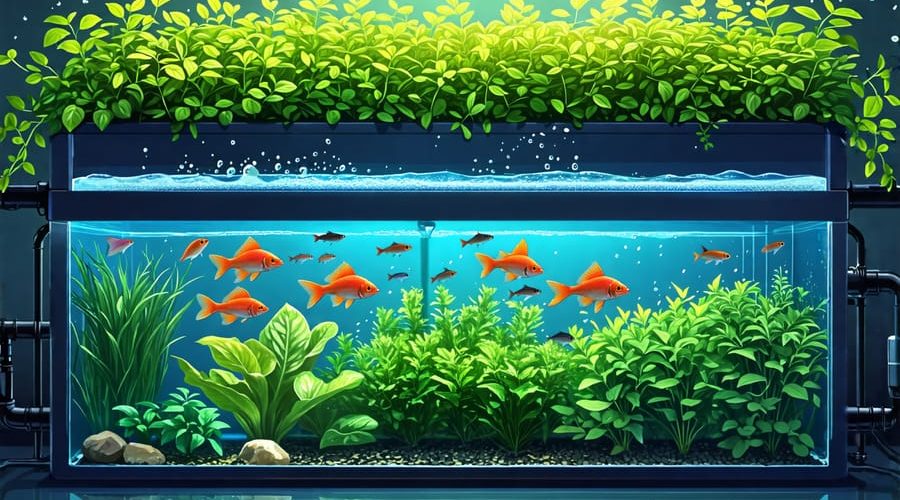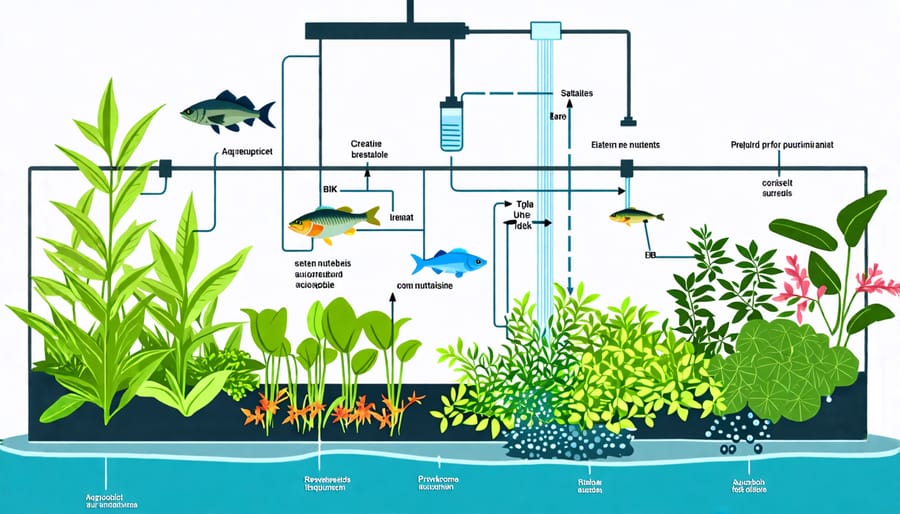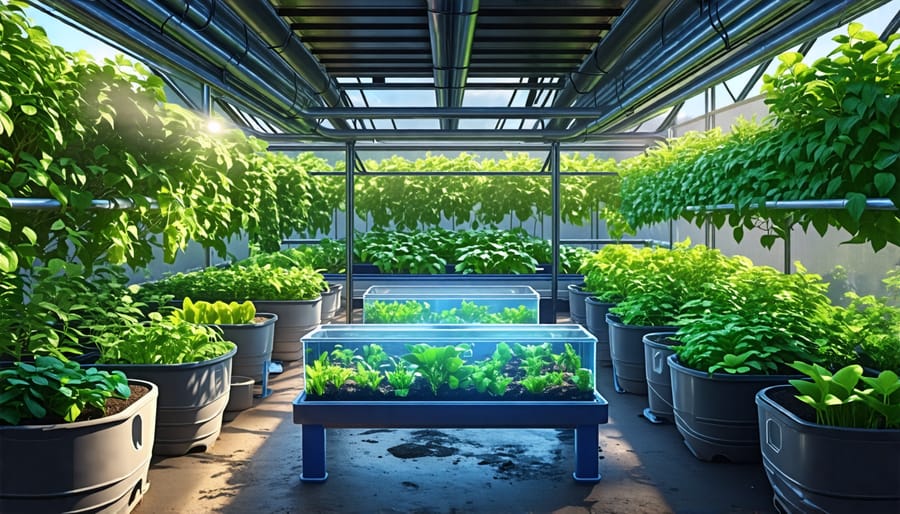
Dive into Aquaponics: The Green Thumb’s New Best Friend
Combine fish farming and hydroponics by creating an aquaponic system that efficiently uses water and nutrients to grow both plants and fish. Begin by setting up a tank to house fish like tilapia; ensure your tank has proper aeration and filtration. Next, install a grow bed above or adjacent to the tank, filling it with a growing medium such as clay pellets. Connect the grow bed to the fish tank with a pump to circulate water, allowing plant roots to filter waste, which also acts as a natural fertilizer. Regularly monitor water pH and nutrient levels to maintain balance, ensuring a sustainable environment for both fish and plants. For those looking for a more in-depth guide, explore the possibilities with aquaponics genius methods.
How Aquaponic Systems Work

The Role of Fish
In an aquaponic system, fish play a starring role by converting fish feed into natural plant fertilizer. As fish consume their food, they produce waste, which is rich in ammonia. With the help of beneficial bacteria, this ammonia is transformed into nitrates, a wonderful nutrient source for plants. This symbiotic relationship ensures the plants get the nourishment they need while improving water quality for the fish, creating a seamless cycle of growth and sustainability.
When choosing fish for your aquaponic adventure, tilapia often tops the list due to their hardy nature and rapid growth in warmer conditions. Other popular picks include goldfish, koi, and catfish, each bringing their own set of benefits. For colder climates, trout and perch are excellent choices, as they thrive in cooler water. Whether you’re just starting out or looking to expand your aquaponic horizons, selecting the right fish is key to cultivating a vibrant and productive system.
Plant Growth in Water
In an aquaponic system, plants thrive due to the symbiotic relationship established between them and aquatic life. Fish waste, rich in nutrients like nitrogen, is transformed by beneficial bacteria into a form that plants can easily absorb. This creates a nourishing environment that fosters robust plant growth. Unlike traditional soil gardening, plants in aquaponics have a constant supply of oxygenated water and nutrients, which means they can grow faster and larger. From leafy greens to juicy tomatoes, the variety of plants you can cultivate is impressive.
My first time setting up an aquaponic garden was eye-opening. Watching the plants sprout and flourish while the fish swam happily below was truly satisfying. The process felt magical, yet it was nature’s simple art. Beginners will find the setup straightforward, and once you see those lush green leaves thriving without soil, you’ll understand why aquaponics is a cherished method among garden enthusiasts.
The Cycle of Water
In an aquaponic system, water cycles between fish tanks and plant beds, creating a self-sustaining ecosystem. Fish produce waste-rich water, which is pumped to plants. Here, beneficial bacteria break down waste into nutrients the plants absorb, purifying the water before it returns to the fish tank, ensuring a harmonious balance.
Setting Up Your First Aquaponic System
Materials and Equipment
To dive into the world of aquaponics, you’ll need a few essential materials and pieces of equipment. Start with a sturdy fish tank; plastic or glass are common choices, but ensure it’s large enough for your fish and plants. You’ll also need a reliable water pump to circulate the water, providing necessary nutrients to your plants. Consider a well-sized grow bed to hold your plants; PVC or food-safe plastics work well. Choose a suitable grow medium like clay pellets that support roots and allow water flow. Don’t forget quality fish food and a pH testing kit to maintain balance. With these materials, you’re set to create a thriving aquaponic ecosystem.

Choosing the Right Fish and Plants
Starting your aquaponic journey is exciting, and choosing the right fish and plants is key. For beginners, fish like tilapia, goldfish, or perch are great choices—they’re hardy and can tolerate a range of conditions. When it comes to plants, consider leafy greens like lettuce, basil, and kale, which are fast-growing and easy to manage. It’s important to balance the needs of your chosen fish and plants, ensuring the environment suits both. Keep the water temperature and pH levels steady, and you’ll have a thriving system. Remember, experimentation is part of the fun, so don’t be afraid to try new combinations!
Building Your System
Starting your own aquaponic system is both exciting and rewarding! First, choose a location that gets plenty of natural light. You’ll need a tank for the fish, ideally made from durable materials like glass or food-grade plastic. Then, set up your grow bed to hold the plants—this can be above or on one side of the tank. Make sure it has a medium like clay pebbles or gravel to support plant roots and allow water circulation.
Install a water pump to move water from the fish tank to the grow bed. This creates a cycle, transporting nutrients from fish waste to the plants and returning clean water back to the tank. Add an air pump to ensure your fish have enough oxygen. As you assemble, think of it as building a small ecosystem where fish and plants help each other thrive. Remember to test the system without fish or plants initially to ensure everything runs smoothly. Enjoy watching your aquaponic garden come to life, knowing that you’re crafting a sustainable system right in your backyard!
Initial Setup and Cycling
Begin by setting up your aquaponic system in a well-lit area. Fill the tank with dechlorinated water and start the cycling process by adding ammonia. Use a water test kit regularly to monitor ammonia, nitrites, and nitrates. This ensures a stable environment for plants and fish, promoting healthy growth and a balanced ecosystem over the first few weeks.
Maintaining and Troubleshooting Your Aquaponic System
Routine Care and Monitoring
Keeping your aquaponic system at peak performance involves a series of daily, weekly, and monthly tasks. Daily, check the water levels and temperature to ensure the fish and plants are happy. Feed your fish regularly, watching for any leftovers as they can affect water quality. Weekly, take a moment to test the water pH and ammonia levels. This routine helps in adjusting the water conditions, ensuring a balanced ecosystem. Scrutinize your plants and fish for any signs of distress or disease. Monthly, it’s time for a deeper clean. Inspect the filters, removing any accumulated debris that could hinder system flow. Also, prune plant roots, as sprawling roots can disrupt water movement. Remember, an aquaponic system is a wonderful example of sustainable gardening, where every action contributes to a healthy microcosm. Personal insights? My lettuce and kale have never thrived better than when I embraced this vibrant gardening approach!

Handling Common Issues
In an aquaponic system, keeping your fish and plants happy can sometimes present challenges, but don’t worry; they’re easier to solve than you might think! Nutrient deficiencies in plants often show up as yellowing leaves or stunted growth. These issues can usually be fixed by checking pH levels and making sure the system is balanced. Adding supplements specifically designed for aquaponics can also help fill nutrient gaps. Now, let’s chat about fish health. Monitor your fish’s behavior for signs of stress, like unusual swimming patterns or not eating. Ensure you’re feeding them the right amount of high-quality food daily. Water temperature and oxygen levels are also key—warm water holds less oxygen, which can stress your fish. Installing an aeration system can make a big difference. Finally, clean the filters regularly to prevent waste buildup, and you’ll keep your system running smoothly. Remember, with a little attention and care, your aquaponic garden will flourish beautifully!
Conclusion and Personal Anecdotes
Aquaponics offers a beautifully symbiotic relationship between plants and fish, making it an ideal choice for those who cherish sustainable gardening. By utilizing this innovative system, you can enjoy fresh, organic vegetables and keep lively fish in a self-sustaining ecosystem. This balance not only reduces your grocery bills but also minimizes your ecological footprint, engaging with nature right in your backyard.
Let me share my personal journey into the world of aquaponics. As a DIY enthusiast with a passion for water gardening, I was mesmerized by the idea of creating an unaffected loop of nourishment and growth. After setting up a basic aquaponic system, I decided to go with the classic choice of tilapia paired with a variety of leafy greens and herbs. Watching the plants flourish as they received nutrient-rich water straight from the fish tank was incredibly rewarding.
Like any project, there were moments of challenge and learning. I remember the first few weeks were spent adjusting the pH levels and ensuring the pump system worked efficiently. But as I witnessed my first harvest of basil and lettuce, a wave of accomplishment swept over me. Each gathering not only filled my kitchen with fresh produce but also reminded me of the harmony that aquaponics brings to life.
This hands-on experience brought me closer to understanding the delicate balance that sustains both flora and fauna. It has become a favorite topic among friends and family, inspiring others to venture into aquaponics. I encourage anyone, whether you’re an experienced water gardener or a curious beginner, to explore this transformative hobby. Not only will it provide endless learning opportunities, but it will also enrich your garden and eco-conscious lifestyle. Dive in and let your creativity flow, just like the gentle currents of your aquaponic system.
